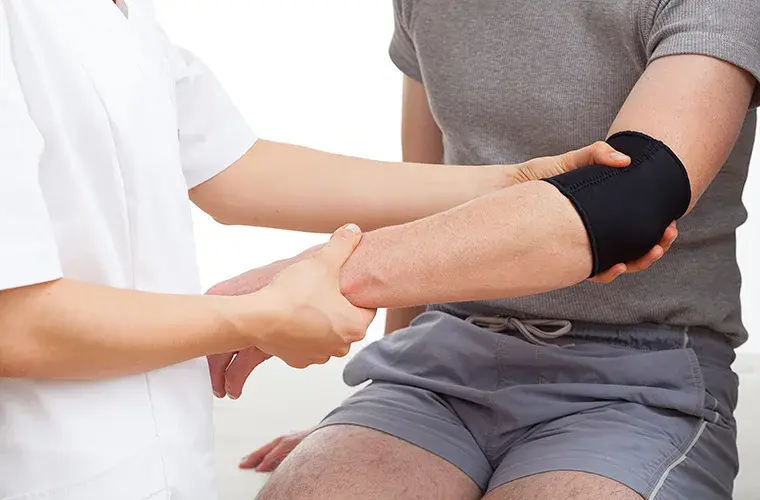Tennis Elbow Support: What It Is, How It Works & Who Needs It
- Priorityontop Work
- Jul 9
- 4 min read
Let’s face it—elbow pain can be brutal. If you’ve ever felt a burning pain on the outside of your elbow that worsens with gripping or lifting, you might be dealing with Tennis Elbow. Clinically known as lateral epicondylitis, it’s a repetitive strain injury where the tendons in your elbow become overloaded due to repetitive motion of the wrist and arm.
But here’s the kicker: you don’t have to play tennis to suffer from it. In fact, less than 5% of people with this condition actually play the sport.

Understanding the Mechanics: How Does Tennis Elbow Happen?
Think about all the things you do daily—typing, cooking, lifting bags, playing instruments. These repeated motions stress the extensor carpi radialis brevis (ECRB) muscle, which attaches to the lateral side of the elbow. When overused, it causes microtears, inflammation, and pain.
Common risk factors include:
Repetitive wrist movement (typing, using tools, etc.)
Poor ergonomics at work
Improper sports technique
Weak forearm muscles
Signs & Symptoms: Is It Really Tennis Elbow?
Wondering if you’ve got Tennis Elbow or something else? Here are the hallmark signs:
Pain or burning on the outer elbow
Weak grip strength
Pain when shaking hands or turning a doorknob
Discomfort that worsens with activity and improves with rest
If these sound familiar, it’s time to take action.
What Is a Tennis Elbow Support & How Does It Work?
A tennis elbow support is a specially designed brace, strap, or sleeve that helps reduce the stress placed on the injured tendons.
Here’s how it works:
Compression: It provides targeted compression to the forearm, which alleviates strain from the elbow tendons.
Stabilization: It limits movements that could worsen the injury.
Redistribution of Force: By shifting force away from the damaged tendon, it allows the tissue to rest and heal.
Improved Blood Flow: Some supports enhance circulation, speeding up recovery.
Types of Tennis Elbow Supports
Not all braces are made equal. Here are the three most common types:
1. Counterforce Brace
Worn just below the elbow
Applies pressure to the muscles
Most popular for acute conditions
2. Elbow Sleeve
Offers full compression from mid-forearm to upper arm
Ideal for mild to moderate pain
Can be worn during physical activity
3. Dual Support Braces
Combines features of sleeves and straps
Offers max support for chronic or severe pain
Each type has its own use case. It’s important to consult a physiotherapist or healthcare provider to choose the best one for your needs.
Who Really Needs a Tennis Elbow Support?
You might be surprised who can benefit from one. Here's a breakdown:
✅ Athletes
Tennis, badminton, squash players
Weightlifters and bodybuilders
✅ Office Workers
Those typing 6-8 hours a day
Poor desk ergonomics = injury risk
✅ Manual Laborers
Carpenters, plumbers, electricians
Frequent tool use stresses tendons
✅ Musicians & Artists
Guitarists, drummers, painters
Repetitive hand motion causes strain
Do Tennis Elbow Supports Really Help?
Yes—but with a caveat. They provide temporary relief and support the healing process. However, using them without addressing the root cause (like poor posture or repetitive motion) won’t yield lasting results.
Scientific studies published in the Journal of Orthopaedic & Sports Physical Therapy show that wearing a brace can reduce pain levels significantly during activity, particularly when paired with physical therapy.
How to Choose the Right Support (What to Look For)
Buying a tennis elbow support? Don’t just grab the first one you see. Keep these factors in mind:
Size & Fit: Snug but not tight
Material: Breathable, moisture-wicking fabric
Adjustability: Velcro or elastic straps are best
Activity Level: Pick based on daily routine
Tip: Check for customer reviews and testimonials. Real feedback often highlights long-term pros and cons.
How to Wear It Properly (And Avoid Mistakes)
Incorrect usage can make things worse. Follow these steps:
Positioning: Place the strap 1-2 inches below the elbow
Tightness: Firm pressure but not so tight it cuts off circulation
Timing: Wear it during repetitive tasks or exercise, not 24/7
Pro Tip: Consult a physical therapist for a custom fitting.
Home Remedies & Lifestyle Changes
A support helps, but it’s just one part of the puzzle. Combine it with:
Ice therapy: 15-20 minutes, 2-3 times daily
Stretching exercises for forearm muscles
Strengthening routines like wrist curls and reverse curls
Ergonomic adjustments at work
Anti-inflammatory diet rich in omega-3s, turmeric, and green veggies
What If It Doesn’t Improve? (When to See a Doctor)
If pain persists despite using a brace and self-care, it may be time to see a specialist. They may recommend:
Corticosteroid injections
Physical therapy
Shockwave therapy
In rare cases, surgery
Ignoring it can lead to chronic pain and limited mobility, so early action matters.
Final Thoughts: Support Is Just the Beginning
If you’re struggling with Tennis Elbow, remember that a brace or support can bring much-needed relief, but it's not a cure. It’s part of a larger strategy involving lifestyle changes, exercises, and medical guidance.
For best results, use tennis elbow supports in combination with proper rehab techniques and avoid activities that worsen the condition. With the right plan, you can heal and get back to doing what you love—pain-free.
Ready to take your recovery seriously? Don’t wait for the pain to get worse. Start by choosing the right elbow support and committing to a smart, proactive treatment plan today.
Struggling with Tennis Elbow pain? Don’t let it hold you back. Book a consultation with a certified physiotherapist today and get a personalized recovery plan tailored to your lifestyle. Relief starts with the right treatment!








Comments